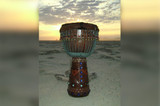Drumming, Now and Then
Whether you are a seasoned hand drum enthusiast, or interested in the community, wellness and overall mood-enhancing benefits of drumming, the roots of the ordinary drum circle are as diverse as its participants. Drumming and drum circles are staples of holistic communities, the underground “hippie” culture and new age aficionados. Drumming activities are also making the rounds in corporations and businesses, providing valuable team building exercises for staff and employees, and within therapeutic environments and schools.
All cultures and societies across the globe have a basis and reverence for drumming, whether as a tool for communication, celebration or expression of spirituality and religion. Drums were discovered in Mesopotamia in 6000 BCE, and continue to hold important roles in cultures across the globe. The African Djembe drum was a communication tool used for ceremonies and is considered an instrument of peace, yet other African drums were used during wars, stimulating soldiers through pulsing cadences. Later, through the integration of African culture within Latin America, drumming found a home that bridged cultures and led to the evolution of Latin, jazz, blues and rock music. Asia’s drums held a similar dichotomy of purpose, bringing both peace and war-like determination to the regions from which they evolved.
Today’s drum circles are a celebration of the positive effects of drumming within a person or group. Drumming is still used as a means of communication, imparting ideas and emotion that are built upon by all members of the circle. Drum circles feature drums and percussion instruments from all corners of the world; this blend of drums, drumming traditions and cultures not only benefits the drummers and listeners, but provides an illustration of the ways in which cultures are able to transcend borders and find common ground, all through the healing power of rhythm.
Since drumming has begun to find a more mainstream niche as a tool for health and wellness, the opportunities for individuals, groups and communities to benefit from drum circles and gatherings are increasing. Even those unable to participate in group drumming events are finding benefits in drumming through therapeutic activities and exercises within wellness facilities, schools and medical environments. The strength of drumming comes from its historical roots of celebration, reverence and inspiration, concepts that are just as vital today as they were in ancient civilizations. Whether in local metaphysics stores or corporate retreats, drumming proves its worth and provides a fun and creative way to experience health and wellness through music and rhythm.
Recent Posts
-
What is the Best Size Djembe for Beginners?
If you're new to the world of percussion and interested in learning the djembe, you're in for a t …16th Jul 2024 -
The Benefits of Becoming a Drumming Teacher: Transforming Passion into Profession
Why become a drumming teacher? Becoming a drumming teacher is an excellent way to share your pas …22nd May 2024 -
What Makes the Djembe Drum a Spiritual Instrument in African Music?
Origin and history of the Djembe drum The Djembe drum originates from West Africa and holds sign …16th May 2024



